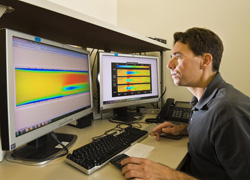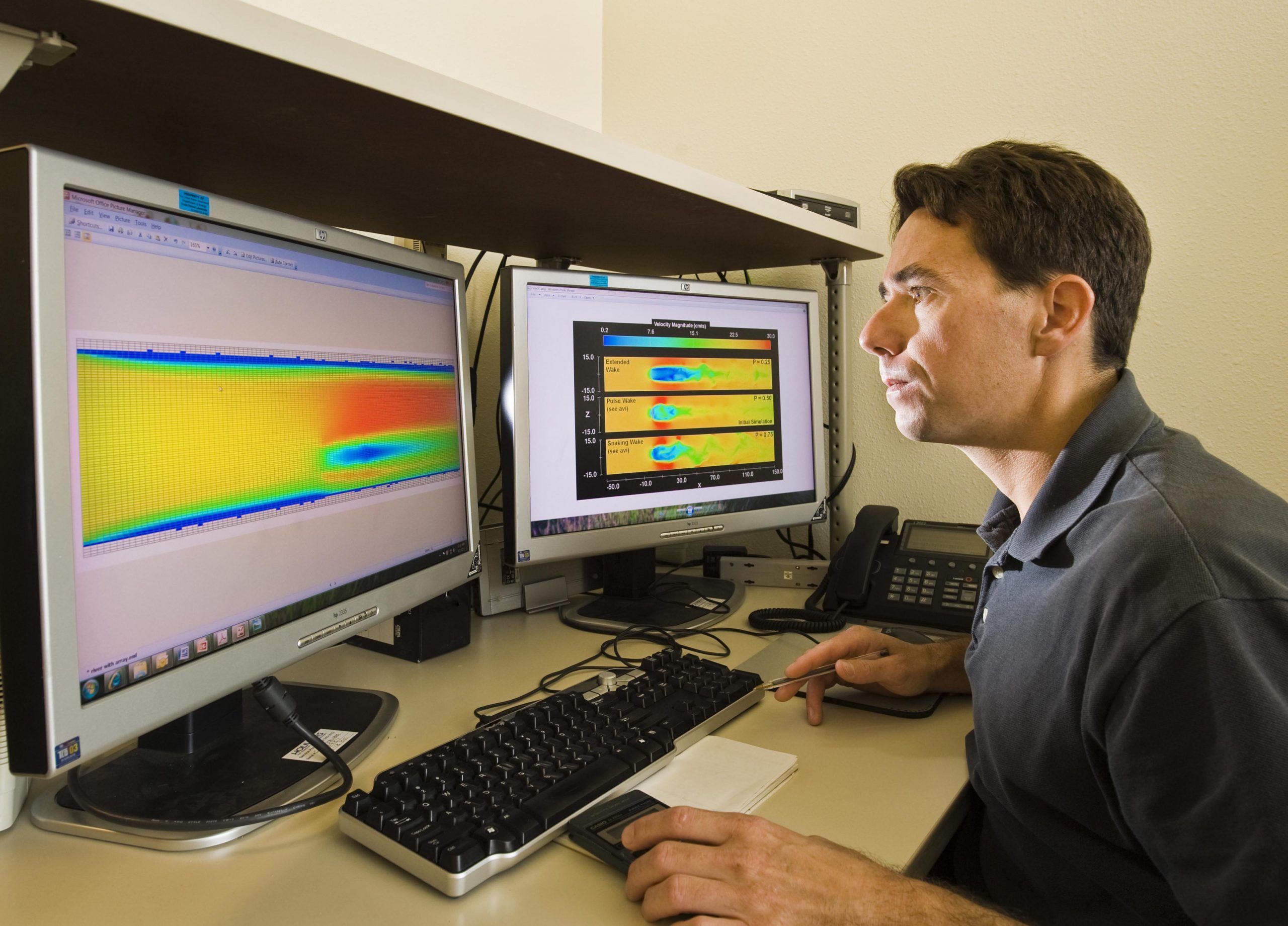ALBUQUERQUE, N.M — A dearth of public information, complicated marine environments and even the corrosive effects of bubbles are among the challenges for companies trying to produce energy from river currents, tides and waves, but Sandia National Laboratories is working on solutions.
Sandia is helping companies on the frontier of the coming marine hydrokinetics (MHK) industry navigate these and other concerns with support from the Department of Energy (DOE).
This fall, the national security laboratory plans to release its first report analyzing the computer-simulated performance of a tidal turbine, a river turbine and a wave-point absorber, which bobs on the surface to capture energy from waves, said Rich Jepsen, a Sandia engineer. Eventually, Sandia will analyze up to 10 devices.
MHK is the study of harnessing the kinetic energy that results from the motion of water.
“The current MHK industry looks a lot like wind did 30 years ago,” said Daniel Laird, manager of the Water Power Technologies Department at Sandia. “We want to take what we’ve learned to compress the MHK development from the 30 years it took wind energy down to 10 years.”
Sandia’s analysis aims to accelerate the MHK industry in the U.S. by helping companies and the DOE better understand where investments can be made to reduce the cost of using America’s waterways and the oceans to produce energy — whether the issues are engineering, environmental permitting or administrative hurdles. Companies will be able to use these reference models to make their own decisions about which design or system components are worth their investment, Jepsen said.
“As a nation, we don’t have a handle on the performance and the actual cost of the energy that is generated,” he said.
Researchers estimate that a significant portion of U.S. electricity demand eventually could be met through tidal and wave energy generation.
Sandia also is getting real-world experience through its partnership with New York City-based Verdant Power, which is at the forefront of the MHK industry.
Verdant operated the world’s first grid-connected array of multiple tidal turbines in the East River and will operate the first commercial tidal power plant in the country, said Dean Corren, the company’s director of marine current technology.
After Sandia began working with Verdant in 2008, DOE awarded an Advanced Water Power Project grant that expanded the partnership to include the National Renewable Energy Laboratory (NREL) in Golden, Colo.
Verdant’s first array of turbines was mounted on monopiles on the river bottom, but the new ones will be mounted on frames. They turn to point downstream to catch the currents as they change to produce rotational energy, like a wind turbine.
“The goal of the project was for Sandia to design a stronger, more efficient blade made of composite materials, similar to what’s used in wind,” said Sandia engineer Josh Paquette.
Sandia surveyed and studied prospective blade foil shapes, performed computer analyses of how water flowed over the rotors, using established fluid-dynamics techniques, and then analyzed the turbine as a whole, Corren said.
The result is a factory-ready blade that is stronger and thicker, and more resistant to corrosion and cavitation, Paquette and Corren said. Cavitation is the creation of tiny water vapor bubbles at low pressure that can collapse and cause surface damage.
“When these bubbles collapse, they put out a lot of energy and it can be very erosive, so it can literally chew up an underwater propeller,” Paquette said. “We tackled this issue using the same methods we used in wind where we did computational fluid dynamics analysis of the blade.”
This Fifth Generation Free Flow System is being built by Verdant and will be tested this fall. Should all go as planned, Corren said, Verdant plans in 2012 to begin installing, in phases, 30 turbines in the East River, which at peak production could supply enough energy for the equivalent of about 700 homes.
Earlier generations of turbines were tested for two months; Verdant’s commercial turbine is designed to operate for three years unattended, Corren said.
Sandia also is learning from Verdant’s experience in the water by studying the debris, mud and biological contaminants that grow on the underwater turbines, Paquette said.
Other companies and government agencies have had a difficult time obtaining research and performance data because nearly all of it is proprietary.
Recognizing the need for consolidated research on water power, DOE asked Sandia to establish benchmark models that companies could use to test their own custom models to decide whether to enter the market, Jepsen said.
Sandia is analyzing basic designs, environmental factors and cost, Jepsen said.
Sandia hydrologist Jesse Roberts said an array optimization computer tool developed by Sandia specifically for MHK devices analyzes environmental effects on the devices and, conversely, the devices’ effects on the environment.
“You can use this tool to place turbines in whatever fashion you think is appropriate throughout your water column to see how they interact with each other,” he said. “It will tell you how much energy you converted with that layout and how the water flow changes throughout the system, near and far field.”
While water flows faster near the surface, potentially creating more energy, turbines sometimes must be submerged deeper so they don’t interfere with shipping, recreation or wildlife, such as birds that dive deeply for their food, Roberts said.
Sandia provides information about how underwater turbines and wave devices change the physical environment to aquatic ecologists at partner labs, who study the effects on marine life. Roberts said while each aquatic environment is different, every question that can be answered up front will help companies predict environmental permitting costs or research requirements.
While preliminary estimates show tidal power can contribute significantly to the U.S. electricity portfolio, a more important point is that these power sources will be located near population centers on the East and West coasts where demand for energy is high.
And, tidal power in estuaries and straits is predictable and steady, as opposed to wind and solar power, Corren said. “We look up at the moon and can know what’s going on, and we don’t have worry about the weather,” he said.
Jepsen also is looking at another potential resource for the MHK industry at Sandia; a 50-foot-deep pool with a nearby large electrical power source that could be adapted to generate waves under the controlled conditions needed for accurate large-scale testing.
With some additional investment, “our lake is big enough that companies could put in a prototype and do full-system tests all the way to generating electricity,” Jepsen said.
There are signs that Sandia’s efforts to help the MHK industry are paying off. Jepsen says a growing number of companies are becoming interested in Sandia’s work on the array optimization tool and materials and coating research for the turbine blades.
“Being in this industry at such an early stage, we have the chance to help define the future of an entire industry. It’s like being a researcher in wind energy 20 to 30 years ago,” Roberts said. “I hope we’ll be able to follow this for quite some time and help influence the direction it goes.”

